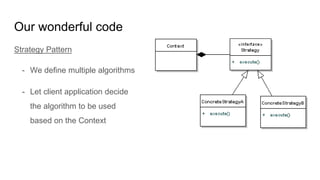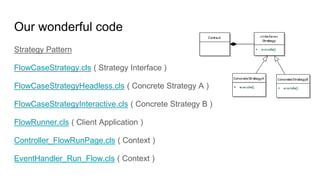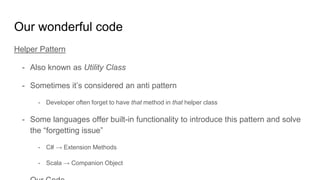Apex and design pattern
- 1. Apex and Design Pattern Quick introduction on Apex and how we used some design patterns to simplify our life
- 2. What is Apex? - Salesforce OOP language - Subset of Java - No import (TrumpScript like), No package - No Stdin, No Stdout - Case insensitive
- 3. Model: â DD ( L ) outside the language ( only point and click interface ) â DAO pattern â Salesforce provides object and api to manipulate data in apex View Visual force page: Markup language ( JSF like ) Controller Apex!!! Idea behind Apex ( from my point of view )
- 4. Show me the code Example: Hello_World.cls ViewModel_BillingItem.cls Util_DML.cls
- 5. Our wonderful code Strategy Pattern - We define multiple algorithms - Let client application decide the algorithm to be used based on the Context
- 6. Our wonderful code Strategy Pattern FlowCaseStrategy.cls ( Strategy Interface ) FlowCaseStrategyHeadless.cls ( Concrete Strategy A ) FlowCaseStrategyInteractive.cls ( Concrete Strategy B ) FlowRunner.cls ( Client Application ) Controller_FlowRunPage.cls ( Context ) EventHandler_Run_Flow.cls ( Context )
- 7. Our wonderful code Abstract Factory - Provide an interface for creating families of related or dependent objects without specifying their concrete classes. - The client software creates a concrete implementation of the abstract factory and then uses the generic interface of the factory to create the concrete objects that are part of the
- 8. Our wonderful code Abstract Factory FlowDefinition.cls ( Abstract Factory ) FlowStep.cls ( Abstract Product ) Flow_ResetPassword.cls ( Concrete Factory ) FlowStep_ResetPassword_UpdateContactPass.cls ( Concrete Product ) InnerFlowRunner.cls ( Client ) FlowStepExecutor.cls ( Client )
- 9. Our wonderful code Helper Pattern - Also known as Utility Class - Sometimes itâs considered an anti pattern - Developer often forget to have that method in that helper class - Some languages offer built-in functionality to introduce this pattern and solve the âforgetting issueâ - C# â Extension Methods - Scala â Companion Object
- 11. Daily Code Review No more than 30 minutes All team is up to date on the code Continuous refactoring => Code highly maintainable Very few dead code Detect immediately classes poorly tested Unify coding style. The code seems written by the same person
- 12. Happy coding with Apex :)
Editor's Notes
- #3: You cannot develop a complete feature on your machine and deploy on the cloud once it is finished.
- #4: The design of the language follows the MVC pattern. They decided to keep the DDL outside of the. It must be made directly through the visual interface that salesforce provide. Internally salesforce provide something like a DAO in order to access and modify the data through the language. The view cannot be manipulated from apex as well but there is a markup language called visualforce page that allows the developer to do that. Eventually Apex is the language used to build all the controller functionalities. From the data validation to the flows implementation.
- #11: (35 classes)












